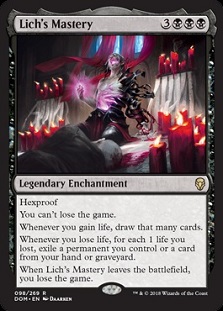Oversoul
The Tentacled One
I didn't own anything close to the cards needed at the time to pull that off! And my methods for getting that many tokens also generally enabled me to cut out the middleman and not use Firestorm as a kill spell. But my card collection in 2000 was diminutive. I did go on to experiment with Saproling Cluster combos, but Firestorm wasn't involved in that. There's potential there, though.You hadnt realized yet that the key to Firestorm kills is handing your opponent a bunch of saproling tokens? Jejeune!
So this came up in one of my long arguments with Spiderman several years ago as a bit of a weird tangent...It occurred to me yesterday, thinking about ancient deck tech vs Modern, that a lot of my Modern competitive tools that are dedicated to fighting Thoughtseize, cards like Spell Pierce and Mana Tithe, are going to be strong against Dark Ritual powered decks because they can allow the ritual to go to the graveyard and then hit whatever it is powering, getting easy 2 for 1 trades that likely stall an opponent for a couple turns. Force of Will changes that equation, though Necropotence is one of the few payoff cards that does not make that 4 for 1 trade look decidedly disadvantageous.
I'd been using Illusions of Grandeur + Donate as a kill condition with Necropotence for a few years and didn't start actively making my whole deck based around it, which I named "HHT" (Here, Hold This) until well after Dark Ritual had been banned in Extended to weaken it. But I wasn't playing Extended and didn't care about that ban. As I refined my deck, it started to look a lot like a deck I had never seen before, but which had been used in Extended tournaments, a Necro Donate variant piloted by Blake Manders and Josh Bennett, described in articles on Star City Games. They called it "Dance Dance Donate Illusions." Anyway, when I was actively working on HHT (it became my go-to deck for casual games against unknown opponents), I went back and read pretty much all of Josh Bennett's articles. And in one of them, he said this...
I think I confused Spiderman when I brought that one up because I didn't give enough context (it was a very long discussion and we were getting bogged down in details). Josh Bennett was talking about piloting a specific deck in the specific environment of Extended in 2000. At that time, there two two common types of opponents who would be likely to cast first-turn Dark Ritual. One type would be likely to follow Dark Ritual up with Necropotence. Hold the Force Spike and use it on Necropotence, and you'd not only get a 2-for-1, but you'd get rid of a card you really wanted not to hit the board. But the other type was more likely to split the Dark Ritual mana across two different spells. A Suicide Black deck might Duress you, see your hand devoid of anything else threatening, take Force Spike, and follow it up with a Dauthi Horror. And even if your opponent was using Necropotence, that first-turn Dark Ritual might still be split across two spells, although it was less likely.Always, always, always, Force Spike an opponent's Dark Ritual. I don't care if you do know that they're playing Necro and not Hatred. Do you remember Time Walk? Now it only costs U. Never give your opponent more mana to Duress away cards. Don't do it. Stop them. Say no. No, you do not get to do what you want.
Same goes for turn 2 Mana Leak. Why let them do anything?
I won't exoll players to always take the 1-for-1. But if you're going to get greedy and hope for a 2-for-1 by holding your counter for the payload of the mana acceleration, I'd at least advocate for understanding the risks. You decide not to counter Channel, your opponent tries to pay a bunch of life to Fireball and you counter it, then you kill your weakened opponent and you feel cool. You decide not to counter Channel and your opponent uses it to hardcast Emrakul, the Aeon's Torn and you don't have answer to that, you don't feel quite so cool.
All that being said, Spell Pierce is generally a good card to have against fast combo decks.
The one time that Dark Ritual was actually banned, I'd argue that the ban was a mistake. But that was a tricky situation anyway.I believe that is an example of how Wizards favors control long games over combo compressed time - Dark Ritual and Thoughtseize are near equivalents in "trade a resource (card or life) for advantage turn 1." That one is banned and the other allowed to be the second most included card in a popular tournament format speaks volumes to how Wizards defines the game post card release.
I mean, Walking Ballista is much more relevant in tournament decks and stuff. But the cards have almost nothing in common and I don't see the point for comparison?Edit: So this Phyrexian Dreadnought you speak of...its like an overpriced Walking Ballista, right?

